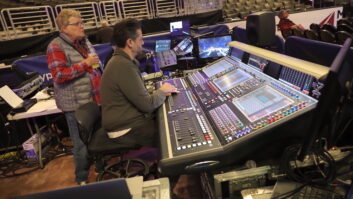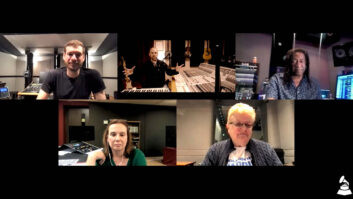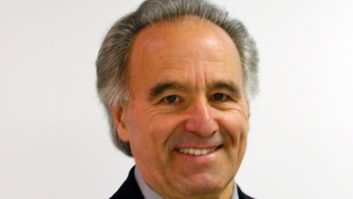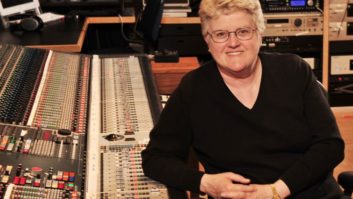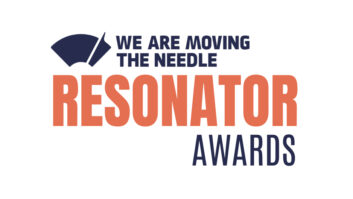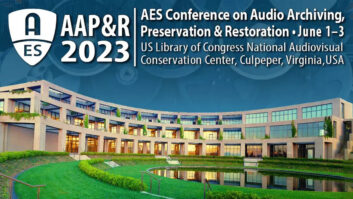A master of the art in the classic sense, Leslie Ann Jones is, first and foremost, a truly musical engineer. Highly respected by her peers, she’s the kind of professional that clients come to depend upon-for her uncompromising dedication to quality, her no-nonsense attitude and, most of all, for her educated ears.
Jones is a bit of a well-kept secret-she’s not someone whose work is all over the pop charts. But it’s the producers, composers, arrangers and musicians she works with who know her true worth, and that’s why she’s one of the busiest people you’ll ever meet. Known particularly for her jazz, big band and orchestral recordings for artists such as Michael Feinstein, Wayne Shorter and Herbie Hancock, and for her impeccable vocal recordings of Rosemary Clooney, Bobby McFerrin, DeeDee Bridgewater and others, she’s also recorded some of the funkiest stuff around with seminal R&B artists such as Maze, ConFunkShun and The Whispers.
In person, “L.A. Jones” is generally quite thoughtful, serious and businesslike, but a puckish sense of humor underscores her get-the-job-done mentality, and those in the know appreciate her relaxed approach to even the largest and most complicated sessions.
Although she continues as a hands-on recording and mixing engineer, Jones is also Director of Music Recording and Scoring for George Lucas’ Skywalker Sound complex in Northern California, and this year she’s also added to her workload the position of Chairwoman of the Board of Trustees of the Recording Academy. With such a nonstop schedule, Mix was lucky to catch up with her between sessions at Skywalker.
You actually started out your music career as an artist.
Yes, I got a Sears Silvertone guitar for Christmas when I was about 14 and started playing it. Then my cousins and I and a friend formed a group-kind of like a teenaged Fifth Dimension-and that was pretty much how I spent my high school years, performing and recording. It was the classic Hollywood story: Every time we’d bring home a record contract everybody would get excited and think we were going to make it, and then we’d get dropped. We got signed to Columbia by Gary Usher, which was great because we got to hang out at Columbia recording sessions; then Gary Usher got fired so we were dropped. Then we were signed to Johnny Rivers’ Soul City label along with the Fifth Dimension, but when the label was bought out we were dropped. It would have been a sad story except that we were having so much fun the whole time.
Your father was the famous musical parodist Spike Jones-was he a big influence on you?
I think he was influential to me in a peripheral way. Because of what he did, I was exposed to all different kinds of music at a very early age. But actually I think it was my mother, whose professional name is Helen Grayco, who more directly influenced me and the kind of live, big band music that I ended up doing a lot of work with. She sang in my father’s band, and I watched her perform every night. Also through her I was exposed to really great singers; she had one of the first Muntz 8-track players in her car and we’d listen to Mel Torme, Barbra Streisand, Frank Sinatra…
How did you make the transition from artist to engineer?
I ended up in an all-woman Top 40 band, playing electric guitar and singing backgrounds. When we went on tour, I was the one who put the P.A. together. Then when the band split up I owned the P.A. By then I was thinking about what to do next-I’d done recording sessions, and I realized that it took something more than I had to be a great musician. I’d never taken lessons or anything; it always came very easy to me to do things like copy Stephen Stills’ guitar solos. And that’s fine up to a certain point, but if you want to be really good you have to do a lot more. So I started working with other people’s bands, helping them arrange their background vocals, sort of semi-producing their live shows, and then I started mixing their sound.
So you were producing and arranging even before you were engineering.
Yeah, in fact I never really wanted to be an engineer. I wanted to be Peter Asher, a producer and a manager. I thought that was a great combination of skills for me because the producer could be the creative side and the manager could be the anal business side.
Meanwhile, I got together with a couple of guys, pooled equipment and started a P.A. company. Obviously it was very hard work, and I really knew nothing-thank God they were patient with me! Then, in 1974-I know that year because this is Tascam’s 25th anniversary year and I was reminiscing with some of the guys there-we bought the first Tascam Model 10 console, which was a 4-bus console, and the half-inch 4-track, the 80-8 I think it was. We set up in the basement of my house, and we also had the idea of putting this stuff in a truck and going to clubs to record bands live and get their demos done that way.
No sooner did we start doing that then my partners got other jobs. Meanwhile, I had a day job at ABC Records in publicity and artist relations. I decided the path I wanted to pursue was to produce and manage, and I thought it was important, if you were going to be a good producer, to know something about what a good engineer does. So I went to Phil Kaye, who ran the recording studios for ABC, and asked him for a job. He wasn’t quite sure, but he said, “Let’s hire you and see what the clients think.” He was very willing to put me on with the understanding that it was extremely rare to have a woman engineer, and that if the clients didn’t dig it, I’d be gone. So, 25 years later, here I am!
At ABC I worked for six months as a production engineer doing tape copies, and then started assisting. There were two rooms that had just been redone with one of the first in-line automation consoles ever built-Frank DiMedio consoles with API/Allison automation. It was the kind of automation [Ed. note: before SMPTE!] that you couldn’t record on an edge track; you’d record on one track, and you’d bounce that to another track-basically you’d bounce it back and forth until it screwed up. I spent most of my time on that first project in the tech room asking a bunch of questions and trying not to look too terribly stupid.
A year-and-a-half after that I was doing a lot of dates with Reggie Dozier and Barney Perkins, who were two very popular black staff engineers. They were always working on more than one project at a time so it was great for me-they’d be mixing and I’d get to do their overdubs, or I’d get to help them track.
Then I assisted on a John Mayall album, and when it became time to do his next album, he asked me to engineer it. There was something about me being able to tweak tape machines that he liked-I don’t know how you make that leap from tweaking tape machine to engineering someone’s record, but that was the first record I did.
At ABC you often worked with Roy Hallee, one of the all-time greats.
That was one of the best things about being there; I learned so much from him. Not just the nuts and bolts of getting it on tape, although all of that, too-learning to punch in fast, how to work with musicians and the conductor, aligning the tape machines absolutely perfectly, putting tones through the faders so you knew your echo returns were absolutely right-because Roy would not accept anything that was less than perfect. It wasn’t just about making sure it was tweaked, it was about making sure it was perfect so you could then go on and be creative. You didn’t have to go back and check things. But I also learned from him in a real creative engineering kind of way. The wonderful textures he creates-working with him was really pivotal for me. Go listen to Paul Simon’s Hearts and Bones album, the album before Graceland-there’s a song on that called “Train in the Distance” that’s a wonderful example of Roy’s work.
You went from ABC to David Rubinson’s Automatt Studios in San Francisco, and then back to Capitol in Los Angeles.
There were a lot of politics and changes at ABC, and it became time to leave. But I was in that funny place that so many people are in-you’ve done just enough work as a first engineer that you don’t want to go back to being an assistant, and you don’t have enough credits to be a first engineer. I don’t envy people who find themselves there; it’s very tough to know when to make that break.
When I was ready to move on, Mix magazine had just come out with studio listings and I started sending my resume out. I saw Fred Catero’s name listed as David Rubinson’s engineer at The Automatt. Fred was another icon; I’d always admired his work, all the Big Brother records and Blood Sweat and Tears, and I knew he and Roy Hallee had worked together at CBS in New York. I figured it was a shot in the dark, but I sent my resume up and three days later they called.
David had just taken over CBS/San Francisco. He’d had one studio in the complex, and when CBS closed he had to either take over the building or lose his studio. So he found himself with three studios and a mastering room, no studio manager and no staff. They couldn’t offer me a job as a first engineer, but I took the job because I knew I was capable and that opportunities would present themselves. And that’s exactly what happened. Not long after I started somebody needed strings done and they didn’t have an engineer. Because of David Rubinson, who managed Herbie Hancock and other artists, at The Automatt we were on the cutting edge in a lot of ways-we were the first studio in San Francisco to be automated, we did the Apocalypse Now soundtrack, we did Santana’s Swing of Delight album on one of the first 3M digital 32-tracks with Carlos, Herbie Hancock, Ron Carter and Tony Williams. I worked with so many really great artists there like Herbie, Carlos, Maze, ConFunkShun, Angela Bofill…there was always a lot going on. The Automatt closed in 1984, and after that I was an independent engineer in the Bay Area for three years until I took the job at Capitol.
I once heard a well-known horn arranger come out of a session with you and say, “Her ears are amazing-she really gets it!” Do you think you have perfect pitch?
No. [Laughs]. I can say that because I know people who do. I think I have really good pitch, but with me it’s something more like what you might call multitasking. My brain is somehow able to do a lot of things at the same time, and I’m able to keep an ear open to the performance constantly no matter what else I’m doing. That makes it possible for me to hear things pretty readily-for example, if we’re doing horn overdubs, to hear if somebody comes in wrong, or there’s a bad note or somebody didn’t play. That’s probably why people started asking me to produce.
Speaking of horns, what are some of your favorite horn mics?
I like RCA DX77s or Neumann TLM170s on trumpets; U87s or RCA 44s on trombones and U67s on saxes. Would you tend to compress trumpets or saxophones when you are recording?
Generally, I don’t anymore. I used to when I first started out, because I didn’t know how to record-I used it as protection, and because I was working with people who maybe weren’t that great at controlling their own dynamics. Working with great players helps because they set their own balances quite well.
But that means you’re doing a lot of riding while you’re recording.
Yes, especially in softer sections, if the trumpets change to mutes or something like that. I try to bring them up when I’m recording. If I don’t, every time we play the tune back I have to make a level ride for people to hear it the way the arrangement is supposed to be heard, and I’m too lazy to do that!
Obviously you don’t get that many rundowns. Do you know what’s coming up from reading the score?
From reading the score and watching the band.
Watching the band to see when they’re going to play softer or louder?
Usually I don’t worry about it when they’re going to play louder, only when they’re going to play softer. I try and get my loudest level right away and then work from there. Same thing with saxes; if we’re cutting a live solo, I can’t record the section too hot, because when the person goes to take a solo I don’t have any more headroom. I have to record the saxes lower, and all the rest of the horns lower so when the solo happens I’ve got enough headroom to bring it up. People need to walk into the control room to hear the playback and know that they played it perfectly, so I record it that way. It’s not that hard, really.
Any tricks for recording saxes?
No tricks, but sometimes an RCA 44 sounds really good on an alto or soprano sax, especially if it’s a real nasal or reedy-type sound. Also, when I’m doing trumpet solos, if I’m using a DX77 I’ll put it in omni for the mute work. It makes it sound more round and less harsh.
What are you listening for when you record a big band?
The internal balance of saxes; making sure there’s enough lead trumpet. Also the bass has to be articulate.
I’ve heard you quoted as saying: “When you’re an assistant, think like an engineer, and when you’re an engineer, think like a producer.” Many engineers just record whatever they’re given-but you’ve always acted more like a producer on that end-speaking up if something wasn’t right.
I suppose that’s why a lot of people feel comfortable going into the studio with me without a producer, or why some producers like to work with me-they know there’s a certain thing that I can take care of that they don’t have to pay too much attention to. They know that I’ll catch it if something is wrong. That’s just always been part of what I do.
What consoles do you prefer?
I work on Neves because that’s what I’m used to. I’ve never been an independent long enough to have to learn a lot of different consoles, which is sort of a blessing and a curse at the same time. When I was at The Automatt, we had Harrisons and Tridents, and then I was at Capitol for nine years and all the consoles were Neves.
So, obviously I’m very comfortable with Neves and I like the way they sound. The one we have at Skywalker is the new VXS, which I think is outstanding. It’s an upgraded V Series with improved power supply distribution, improved mix buses and an 8×8 post panel for film and 5.1 mixing. As far as automation goes, I think Flying Faders is still one of the best automation systems around-it’s very easy, very fluid.
Is there any equipment you can’t live without?
Well, for tracking or mixing I would have a very difficult time without my speakers. They’re Tannoy Limpet 8S-the self-powered dual speakers, PBM-8s with the Canadian Limpet amplifier on the back. I own two pair so that I can do LCR with them.
There isn’t anything else I really have to have, although I’m getting close to buying an original [Lexicon] 224 for myself. They’re getting very hard to find now, and none of them have been kept up very well, so I’m thinking of getting one of my own. I find there’s something refreshing about older reverbs that haven’t been so tweaked to death in terms of their algorithms. They’re a little more pure, a little more natural-sounding. That’s probably why the EMT 250 retains its popularity-it’s got only four settings and you can do maybe a total of 16 combinations with it, but it has a sound that, for something artificial, is pretty remarkable.
You’re known as an expert vocal engineer. How do you go about choosing vocal microphones?
I don’t think I do it differently from anybody else. With experience you get an idea of what the characteristics of certain mics are, and if I have the opportunity I’ll stick a couple up and hear the person sing on that particular song. With the instruments, not a cappella, of course. You can’t really hear what a mic is going to sound like on someone’s voice if they’re not singing along with the band; there are too many characteristics that may not show up. It might sound fine if they’re all by themselves, but then you stick them with the track and it’ll sound completely different. There are some mics that don’t sound good on women, and some mics that don’t sound good on men. I find 249s or M49s on women sometimes don’t sound good because they’re a little too bright. When women sing, particularly in their midrange, or when they have to sing out, their voices tend to get a little thin, and those mics may accentuate what you don’t want to hear. A lot of times I’ll go with the tube 47, and since the 149 came out I use that quite a bit. So my group of three would usually be a 67, a 47 tube and the 149.
Do you have a desert island vocal compressor?
Since I bought the Avalon 737, I’ve been using that almost exclusively. I love the way it sounds, I love the control that it gives me and I like having everything in one box that I can duplicate, if I need to, wherever I am. The sidechain in it is great, as well. It leaves the low end and the high end free as EQ and allows you to use the two midrange bands as sidechains. So if you have harshness in the midrange you can compress it and still have top and bottom end EQ available.
Besides that it would be an LA2 or a Summit. The rest I use for special applications-like I tend to use an 1176 on bass quite a bit, usually when I’m mixing, because it really seems to bring it out in the track more than anything else.
You record to analog?
I used to record at Capitol to the 32-track Mitsubishi, which I wish I still had, because on most of the big band stuff I could really use a couple of extra tracks. Now I drag along a DA-88 with the 24-track analog, and I usually put the room mics on the 88, or anything else extra that I need. I find the DA-88 to be quite an incredible tool-I think Tascam has very good-sounding converters and it sounds fine. I use it when I’m mixing now if I have to make an intro separate from the song, like for a practice edit. I’ll mix the pieces to half-inch, lay them over to DA-88 and time the crossfade right. I use 88s for that kind of stuff constantly.
What other new equipment do you like?
At Skywalker we get into the more esoteric stuff, and I’m getting a bit spoiled. For one thing, I’ve been kind of stunned at the difference cables make. I used to think it was a lot of voodoo, but when you get into a place where you can really hear the difference it’s not such voodoo anymore. Not that I would take $7,000 cables with me wherever I go, but I definitely think it contributes to why Skywalker sounds the way it does. We use MIT, Cello and Canare Starquad.
I also love the Pacific Microsonics Model One converter. It’s really difficult now for me to use another converter when I’m mixing direct to 2-track. I use it as a 16-bit to mix to DAT or I use it 88.2/24-bit when I’m doing something high-bit on the DA-88.
So I’m kind of spoiled, but we need those things; we do a lot of direct to 2-track recording and a lot of really kind of critical listening records, the kind of music where that equipment makes a real difference.
What engineers and producers do you admire these days?
Well, Don Murray of course does great work, and Al Schmitt, obviously, as well as Shawn Murphy and Keith Johnson. I also really like Mike Shipley’s work; Shania Twain’s record sounds fantastic-it’s wonderfully tough-sounding. I think some of Bob Clearmountain’s work is absolutely astounding, like Jonatha Brooks’ Ten Cent Wings. As far as producers, John Levanthal and Larry Klein are two of my favorites. Both of them are so talented on their own but you don’t hear their contribution when you listen to the records that they produce. They really enhance the artist that they work with and bring out the best in them without making it seem like it’s their album. That’s really hard to do.
What’s your secret for juggling all your different jobs?
[Laughs] I have a very understanding partner and a good dog. Seriously, the easy answer is because I want to do it all. I took the job at Skywalker because I don’t want to give up engineering. I really love it, but I don’t want to spend 90 hours a week in the studio anymore. And I think continuing to be a recording engineer is part of what makes me a good studio director; if I don’t keep my hands in, then it’s kind of hard for me to have real conversations with other engineers who come in. It isn’t easy to do it all, and I’m really lucky that Skywalker has been supportive of me being so active in the music community-they see it as a positive thing for Skywalker and the studio. And it’s certainly a positive thing for me. Being back in the Bay Area and doing a combination of all the things I love is just about perfect.
ENGINEERING/MIXINGMichael FeinsteinMichael and George (Gershwin)
Dee Dee BridgewaterDear Ella (Grammy winner)
Rosemary ClooneyMothers and Daughters
Wayne ShorterHigh Life
Michelle ShockedChildren’s Album
BB King & Diane SchuurHeart to Heart
Bebe & Cece WinansDifferent Lifestyles
Dave EdmundsCloser to the Flame
Narada Michael WaldenConfidence
Herbie HancockMr. Hands, Lite Me Up, Monster
Carlos SantanaThe Swing of Delight
Bobby McFerrinBobby McFerrin
MazeWe Are One
The WhispersLove for Love
Carmen McRaeCarmen Sings MONK
Angela BofillSomething About You
